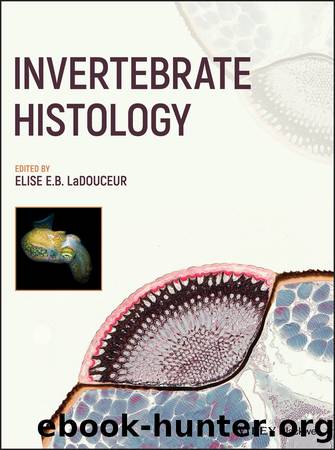Invertebrate Histology by LaDouceur Elise E. B.;

Author:LaDouceur, Elise E. B.; [LaDouceur, Elise E.B.]
Language: eng
Format: epub
Publisher: John Wiley & Sons, Incorporated
Published: 2021-01-28T00:00:00+00:00
Figure 5.41 Brain of an unspecified cephalopod revealing the brain surrounding the esophagus (E). The neuropile (N) is eosinophilic with few cells. The neurons (arrows) are arranged in both lamina (layers; horizontal arrows) and aggregates (vertical arrow). 40Ã. HE.
5.3.7.1 Central Nervous System
The brain is protected within a cartilaginous case located between the eyes and forms a ring around the esophagus (Figure 5.41). Large, oval or reniform optic lobes are present on either side of the brain separated by the optic tract (Figure 5.42). There is a distinct layered cortex and a medulla containing large multipolar neurons. The cortical layers resemble the organization of deeper layers of the vertebrate retina (Figure 5.42 inset). Neuropile is a pale, acellular tissue composed of axonal processes. Basophilic neurons are found peripherally around the neuropile (Figure 5.43). Ganglia are composed of neuronal cell bodies and are arranged in both lamina (i.e., layers) and aggregates, depending on the region of the brain. The optic glands are located on the upper posterior edge of the optic tracts and composed of a wellâvascularized, uniform mass of cells with no obvious formation of epithelia or vesicles (Budelmann et al. 1997) (Figure 5.43).
Download
This site does not store any files on its server. We only index and link to content provided by other sites. Please contact the content providers to delete copyright contents if any and email us, we'll remove relevant links or contents immediately.
| Administration & Medicine Economics | Allied Health Professions |
| Basic Sciences | Dentistry |
| History | Medical Informatics |
| Medicine | Nursing |
| Pharmacology | Psychology |
| Research | Veterinary Medicine |
A History of the Human Brain by Bret Stetka(494)
The Spike by Mark Humphries;(466)
Basic Exercise Physiology by Moran S. Saghiv & Michael S. Sagiv(465)
The Plague Cycle by Charles Kenny(447)
The Whole-Body Microbiome by Brett Finlay & Jessica Finlay(425)
Virus Mania by Torsten Engelbrecht; Köhnlein Claus(401)
Reviews of Physiology, Biochemistry and Pharmacology by Unknown(384)
The Genetic Lottery by Kathryn Paige Harden(381)
Your Brain on Exercise by Gary L. Wenk(346)
Lymph & Longevity by Gerald Lemole(346)
Biophysics of Membrane Proteins by Unknown(327)
Soft-Wired: How the New Science of Brain Plasticity Can Change Your Life by Dr. Michael Merzenich Phd(299)
Fixing My Gaze by Susan R. Barry; Oliver Sacks(291)
Anatomy of the human body: Anatomy body part by Anik Ahmed(290)
Corona, False Alarm?: Facts and Figures by Karina Reiss && Sucharit Bhakdi(285)
Netter's Clinical Anatomy E-Book by John T. Hansen(282)
Structural Immunology by Unknown(258)
Essentials of Pathophysiology by Tommie L. Norris(246)
Brain Weaver, Volume 1 by Andrew Newberg(226)
